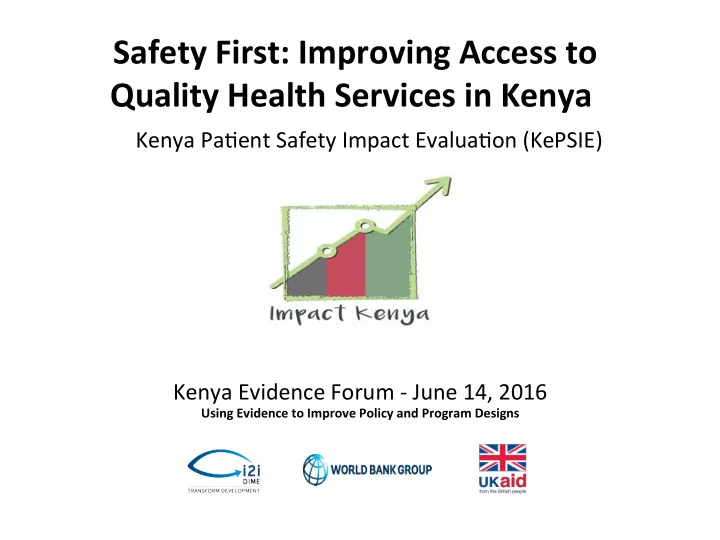

Safety First: Improving Access to Quality Health Services in Kenya Kenya Pa:ent Safety Impact Evalua:on (KePSIE) Kenya Evidence Forum - June 14, 2016 Using Evidence to Improve Policy and Program Designs
What percentage of health facili:es comply with minimum pa:ent safety standards in Kenya as per current regula:on? 1. 20% 2. 3% 3. 65% 4. 90%
We do not know… But based on our baseline data collec:on in all facili:es in Kakamega, Kilifi and Meru (~1,100 HFs) 3% of facili:es comply with minimum pa:ent safety standards
What percentage of procedures are performed with new (as opposed to reused) needles and syringes in Kenya? 1. 57% 2. 21% 3. 100% 4. 78%
Based on the same baseline (~19,000 observa:ons of HCW-pa:ent interac:ons ) 100% of procedures were conducted with new syringes and needles
Two important messages to start… 1. Policy ac:on is required to move facili:es above minimum paFent safety standards 2. Kenya has done a great job in a key area: new needles and syringes
Can inspec:ons help improve pa:ent safety in Kenya?
Constraints Iden:fied in the Health Inspec:ons System (Windsor, 2013) • Discre:onary Rules/Standards • Not well known Monitoring/ • Low probability of inspec:on (4-8%) • No monitoring system (paper records) informa:on • No capacity to follow-up systems • Limited informa:on to HFs Enforced Sanc:ons • No warnings or sanc:ons, but extreme cases and rewards Weak incen:ves for HFs to improve pa:ent safety
Ke KePSIE A cou A c ountry-l -led ed i ini5a5ve d e devel elop oped ed b by c con onsen ensus “Windsor Agreement,” 2013 1. Support regulatory reform of the inspec:ons system; 2. Develop instruments to Kenya(Healthcare(Federa3on ! Ministry(of(Health ! measure and monitor pa:ent safety Radia3on(Protec3on(Board ! Nursing(Council(of(Kenya ! Medical(Prac33oners(and( Clinical(Officers(Council ! Den3sts(Board ! 3. Evaluate the impact of accountability Kenya(Medical(Laboratory( Technicians(and( Kenya(Nutri3onists(and( Pharmacy(and(Poisons(Board ! Technologists(Board ! Die3cians(Ins3tute ! mechanisms–through different models of health Kakamega' County' Government ! inspec:ons–on pa:ent Meru(County( Kilifi(County( Government ! Government ! safety Building on the long-term Health in Africa Ini:a:ve work on regulatory reform
✔ 1. New Regulatory Framework GazeSed in 2016 Standardized ü Checklist Warnings & ü SancFons Risk-based ü Scoring system For private and public faciliFes (only private facili:es were inspected before)
✔ 2. Measuring PaFent Safety – select results (I) Census in all facili:es in 3 study coun:es (Kakamega, Kilifi, Meru) 97% of facili:es need to improve above minimum score 1 Facility Performance on PaFent Safety 300+ items (Percentage of Facili0es, 3 study coun0es) 65% % of faciliFes 32% 3% 0% Minimally Compliant Par:ally Compliant Substan:ally Compliant Fully Compliant (11 - 40%) (41 - 60%) (61 - 75%) (>75%) Risk Category (score/max score) Public facili:es score beier than private facili:es 2 66% of facili:es are private but 71% of pa:ents are aiended in public facili:es
✔ 2. Measuring PaFent Safety – select results (II) Census in all facili:es in 3 study coun:es (Kakamega, Kilifi, Meru) Hand hygiene is only performed in 2% of the cases when 3 it is indicated (cornerstone of IPC) HCW knowledge and access to supplies do not always 4 help with safety prac:ces (Know-Do Gap) Hand Hygiene Before InjecFon or Blood Draw 68% Knowledge 70% Supplies 2% PracFce
What is coming next à 3. EvaluaFon of intensive inspecFons Web-based Training Electronic 1 2 3 Monitoring the first InspecFons System with cadre of detailed full-Fme performance inspectors of all faciliFes
Implementa:on Intensive inspec:ons • 100% probability of inspec:ons • Enforcement of warnings and sanc:ons • Disclosure of facility performance In context: Kenya is one of the only 5 countries (out of 45 in SSA) that actually conduct inspec:ons in health facili:es To be con:nued
Thank you! KePSIE Team Guadalupe Bedoya Jishnu Das Jorge Coarasa Amy Dolinger Ana Goicoechea Njeri Mwara Khama Rogo Frank Wafula
Recommend
More recommend